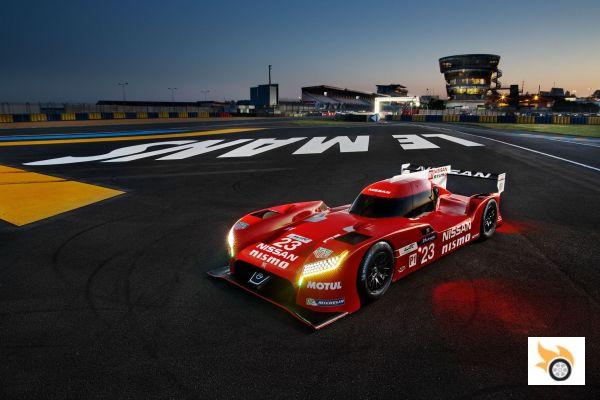When you face a race like Le Mans, in a circuit that has as its hallmarks its very long straights, the importance of acceleration at the exit of the chicanes, and the performance in fast corner for the "Porsche eses", and mix it with a specific fuel limitation set by regulation, and the management of reliability and tire wear control, you have an explosive cocktail. A cocktail that only the greatest are capable of making with guarantees of success.
Today we want to tell you how Porsche has created the ultimate recipe to win Le Mans 2015 with a product, the Porsche 919 Hybrid, which has managed to mix in a package numerous solutions, all interconnected with each other, to meet the goal of taking the trophy for the 17th time to the museum in Stuttgart. If you join us, you'll see that the 919 Hybrid didn't have "one magic solution" that allowed it to win, but was the result of an accumulation of masterful ideas designed to create the "ultimate racing car". Definitive for 2015, of course, because work is already underway on next year's car, which is sure to be faster, more efficient and better.
The origin of the species
In 1998 Porsche took its last victory at the 24 Hours of Le Mans with the 911 GT1. For 1999 the ACO had prepared a regulation where everything was to be concentrated on prototypes, and the Stuttgart firm, which was going through serious financial problems, had developed the so-called LMP2000 (or 9R3). That LMP1 had to be the successor to the 911 GT1, and considering the sporting experience of the firm, no one doubted that, whatever Porsche did, the car would be competitive.
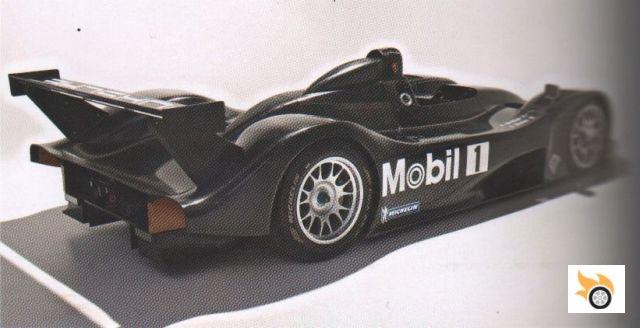
Porsche had an LMP1 developed for 1999, but the project never ran.
For years, Porsche denied the existence of such a race car. It simply dismantled its official sports program, with the excuse of expenses. The intra-history tells that one of the demands of VAG to collaborate in the Cayenne-Touareg project was that Porsche would not race with that car, and leave space for Audi to succeed in endurance. In fact, not a few engineers, technicians and drivers would change the Stuttgart firm for Ingolstadt.
In a way, this cancellation meant that Porsche lost along the way the freshness of making racing cars every year. But the good results of the Cayenne and the pressure from Penske to have a Porsche-made race car to participate in the American Le Mans Series allowed the company to create the RS Spyder, an open race car designed for the LMP2 category and launched in 2005.
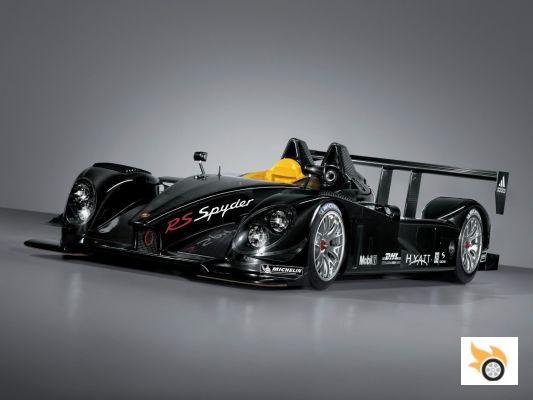
Porsche RS Spyder LMP2
The RS Spyder would serve not only to dominate its class and also win at Le Mans in 2008 and 2009, but to dust off the rust on Porsche's race car design team. The ACO would institute the cost limit for 2010 in LMP2, and kill Porsche's Le Mans aspirations, as their car was clearly more expensive than the mark, but in any case, the lessons learned with the RS Spyder would serve to evolve new concepts that would make the 919 Hybrid a winning car.
The magic suspension
Porsche has a closely guarded secret to itself, one that it barely talks about in any interviews, and one that it has only dared to say anything about on the odd occasion this 2015. With so few details, we've had to dig around and study patents, photos and technical documentation to get a clear idea of what goes on inside the 919.
By 2009, Porsche had spotted one of the key problems of modern racing cars, thanks to the development of the RS Spyder: The importance and influence of the car's pitch on an aerodynamic (and also dynamic, why not say it) level.
With ground effect tunnels more and more limited by regulation, making the car's flat bottom work properly is more and more vital. And to make it work "the way you want it to", aerodynamicists are obsessed with keeping it consistently inclined to the track. That is, to keep the angle of the bottom of the car constant with respect to the tarmac.
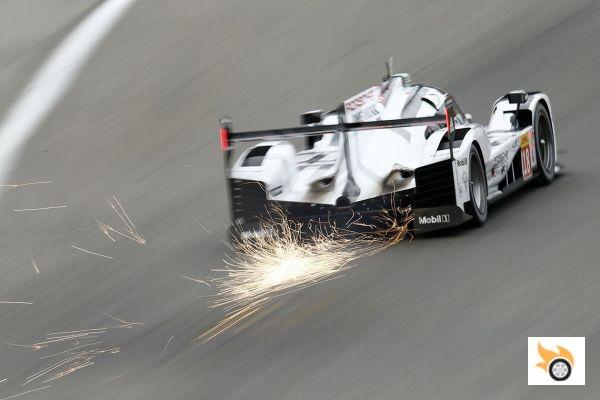
Any change in this angle implies changes in the downforce of the car, both at the front and rear axles, and can also cause drastic variations in the downforce distribution, so the driver can find himself with a car that suddenly changes from oversteer to understeer, or from sticking to the tarmac to four-wheel drift.
To control this angle with extreme precision, what has happened over the years is that the suspension has been stiffened more and more, and at the same time, the damping restrictions have been increased. Damper tuning has taken a leading role here, as it is not only important to control the pitch of the car (how much the nose dives under braking), but to prevent the car from "bouncing" on the front suspension when pitching. With a traditional suspension, this is achieved by making the springs stiff, and the dampers very... damping, redundantly.
But this takes an expensive toll on the other dynamic properties of the chassis and sacrifices the roll behaviour of the car. Due to this "anti-sway" design, where the main aim is to avoid front-end bounce, the dampers are extremely restrictive. When the car goes into a corner, as you know, it leans more on the outside wheels than on the inside ones, and that makes it lean. The problem is in the transition time between when the car starts to lean, and when it reaches the desired lean and is leaning squarely into the corner.
The time it takes for the car to reach lean is mainly determined by the damping in the wheels. Because very restrictive dampers are fitted to prevent pitching, they are too restrictive to allow the car to reach its desired roll in the corner in a reasonable time.
Why does this happen? Because the pitch inertia of the car (the "urge" it has to sink the nose when pressing the brake, or the urge it has to lift under acceleration) is very high, but the roll inertia (the urge it tends to lean laterally when cornering) is much lower, as race cars usually have a very low centre of gravity, and well adjusted with respect to the longitudinal lean axis of the car.
The result? Porsche engineers, like many other race car engineers, realized how complex it was to set up the car to avoid pitching and how much it compromised the cornering behavior, the car's support in the corner, when responding to pitching.
So in 2008 or so, Achim Schulz, Porsche's development engineer in Weissach, came up with a mechanical solution to the problem. The solution would, in fact, be patented in 2009. The basic concept is what you have in the figure below.
I'm not going to get all "professor of mechanisms" and talk to you about vectors, but I'm going to give you a simple explanation so that you understand what the patent is all about.
The first thing is to know the purpose of the system: What Porsche is patenting here is a system that allows to control with different elastic and damping elements the pitch and roll movements of the car (and the passage over bumps, too). With the independent control of pitch and roll by means of "springs and dampers" (I put it in quotation marks because a torsion bar is used in one of the elements), what Porsche gains here is the possibility of configuring the car so that it pitches as little as possible without compromising the behavior when going over bumps or cornering.
How does it work? It's not too complicated to understand. Let's start from the obvious: When the car pitches, the two front wheels rise relative to the body (the nose dips). On the other hand, when a car takes a corner, the wheel outside the corner "goes down" and the wheel inside the corner "goes up" and goes deeper into the body. If you hit a pothole, something almost similar to cornering happens: The wheel that hits the pothole goes into the body, but the one on the other side stays where it was.
The key to this bar system is to create a mechanism that plays with these movements. To the point: when the car pitches, the wheels (12 and 13 in the figure), go up at the same time and in the same amount, right? Because of the shape of the rod system and the joints, this compresses elements 4 and 5, which are the concentric spring and shock absorber. Since both wheels go up the same amount, element 17 doesn't rotate (this is important). Are you with me this far? are you clear on this? Well, the key for engineers is to set up elements 4 and 5 (spring and shock) to control the pitch therefore. They can be tuned exclusively to prevent the car from dipping the nose too much, or bouncing when dipping and seeming to "say yes" with the head when braking or accelerating.
On the other hand, when the car takes a corner, wheel 12 goes up and wheel 13 goes down in equal measure (or vice versa, depending on whether the corner is left or right). As both wheels move the same distance but in different directions, the set of elements 4 and 5 do not suffer "compression stress", that is, they are not compressed and do not come into play. On the other hand, what does happen is that element 17, which is a lever arm, rotates (if you pay attention you will see it clearly), and when it rotates it makes element 19 rotate with respect to the "WD" axis, and that makes shock absorber 6 compress or expand and bends element 16 which, in its extension, is a "blade" type torsional bar that twists and acts as an elastic element, that is, as a spring.
In this way, elements 6 and 16 control the alternative movements of the wheels (when one goes up and the other goes down), so they can be tuned thinking only and exclusively in the control of the roll of the car, without elements 4 and 5 influencing anything (remember, those are tuned for the pitch).
Complicated? It may seem so, but if you spend a little time on it, you'll get the hang of it for sure.
And what happens if you hit a pothole? Well, here things get more complicated. As one wheel doesn't go up the same as the other goes down, the behaviour of the system is a combination of all the elastic and damping elements (4, 5, 6 and 16) working in unison, which adds to its stiffness and damping control, which is not a bad thing if you know how to control everything.
This system also has another cumulative advantage: It reduces the amount of elastic and damping elements that must be used compared to other solutions to control the roll of the car independently of the pitch, such as mounting a third spring-damper, as is done in many Formula, or as Peugeot did in their 908 LMP1 years ago. Less elements, less weight, less things that can go wrong.
The patent would be approved in 2011, and Porsche would keep it for itself. We, who prowl through patent records looking for works of car brands, to see what they are cooking, we saw it then, but we did not know how to assess its relevance at the time.
The 919 is born, and Porsche fools us all.
In 2013 Porsche's LMP1 project was officially born, with a view to compete in 2014. The Stuttgart announced that they would test the car for a year, and then go on to compete with it. In reality, the project was already being cooked two years before and seeking approval from the board of directors.
But the big deception would come from Porsche's master designers. The firm showed us a bunch of technical figures about its 919 Hybrid, and one of them showed us the front suspension sitting on the carbon fiber chassis. It looked like this.
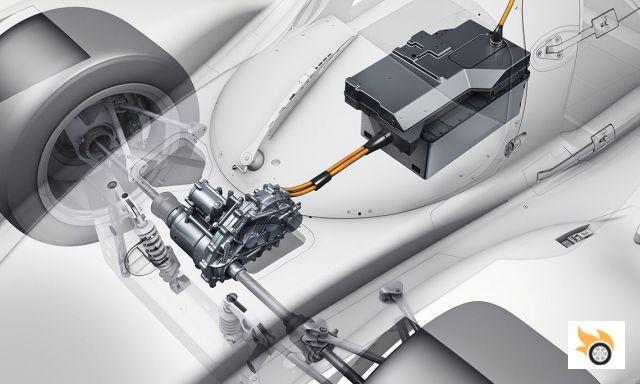
For starters, the car in the figure had no torsional bars as a suspension element, and supposedly made do with a simple linkage acting on the standard springs and shocks. Very simple for a Porsche, we thought at the time. But it wouldn't be until 2014 when, it would slip into Race Car Engineering a photo of the system that Porsche was actually employing, and of which the technical magazine claimed to have no idea how it worked.
This is when we started to remember the patent of the original Porsche system, and when we realized the trick the firm was hiding. The Germans were using their patented system on both the front and rear axles, giving them a competitive advantage that their rivals were still slow to understand.
But beyond the suspension, the original 919 Hybrid had many other technological aspects. The Stuttgart-based company had so many new fronts at the same time that it preferred to divide its efforts and not take too many risks. Thus, last year's car used a chassis split in two halves and glued together, a more or less conservative battery (no attempt was made to run in the 8 MJ category), and had overweight problems.
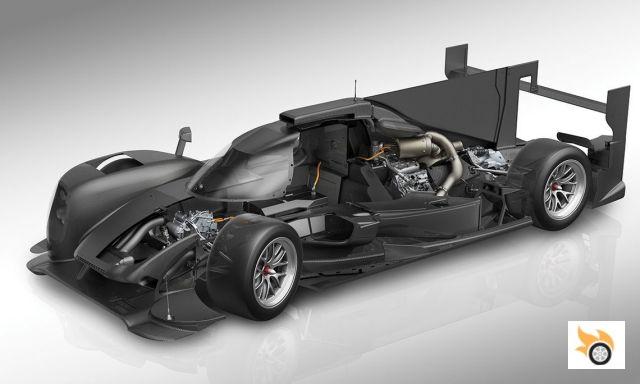
In addition, the use of the peculiar suspension system consumed the tyres too much, while the power of the hybrid system and the aerodynamics demanded even more from the front wheels.
The technical specification of the car was clear: a carbon fibre coupé with a four-cylinder mid-engine with direct petrol injection and conventional turbocharging. The energy capture and reuse was done by means of a motor-generator on the front axle, dedicated to capture energy during braking by taking it from the front wheels, braking them, storing this energy in a lithium battery, and then using it to accelerate the front wheels at the exit of the curves.
In addition, a second electric generator was used in the form of a small turbine installed in the exhaust pipe, after the turbocharger, rebañando the excess energy from the exhaust gases to store it as extra energy in the battery to use it accelerating the car more if possible.
After the 24 Hours of Le Mans last year, Porsche had clear problems with the car, although it was very fast on a lap, it was not consistent, and at the same time they realized that it was better to play in the maximum category of energy regeneration to win at Le Mans, if they were able to put the car within the minimum weight by regulation (870 kilograms).
919 Hybrid 2015: Almost completely new, but with the same basic concept.
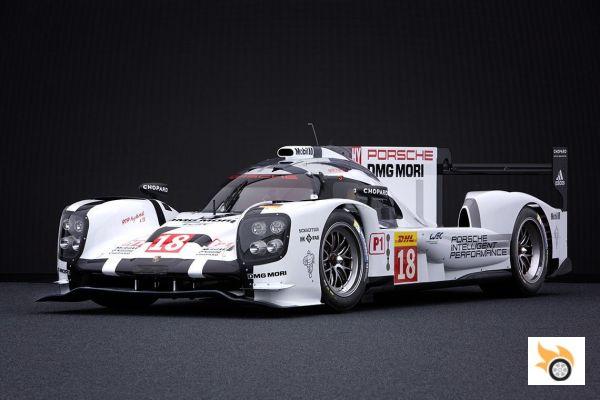
With clear priorities to win at Le Mans 2015, Porsche accelerated all the technical developments it had planned for the coming years.
It started with the chassis. As we told you weeks ago, the 919 Hybrid debuted a brand new, one-piece monocoque, where new types of fibers and new construction techniques were used from their partners at Capricorn (you'll be familiar with the company, as their CEO was the Nürburgring buyer last year, if you recall). Thanks to the redesign, the car was able to lighten its weight in terms of chassis, and the suspension was repositioned. However, the original and patented system was kept.
A photo from our friend and occasional editorial contributor Mike Fuller (Mulsanne's Corner), which he has lent us for the occasion (thank you Mike!), allows us to see how the 2015 919 Hybrid still retains this new system, but packaged differently.
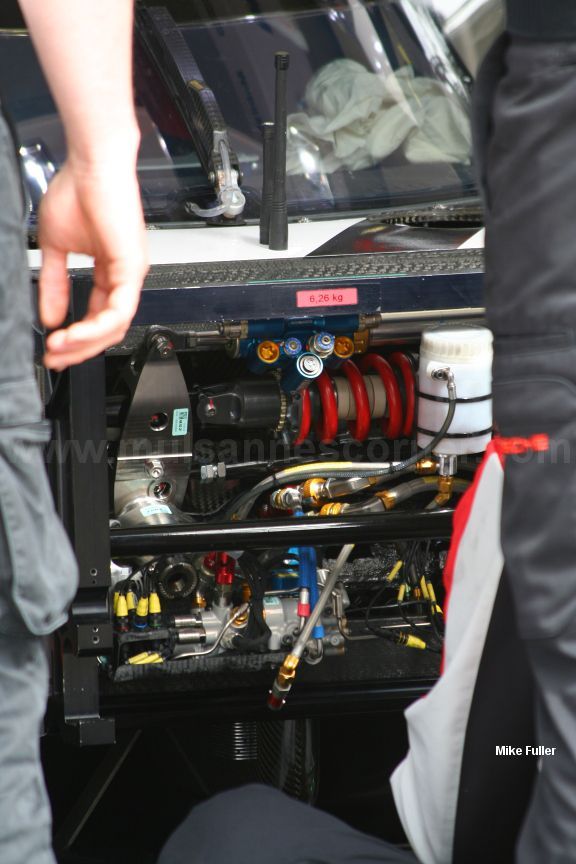
The development of a new battery was fast-tracked with technical partner A123. This battery was designed to be fitted to the car in 2016, but since cars with 8 MJ had such a competitive advantage by regulation, Porsche didn't want to wait any longer and forced. In any case, the chassis design was made in such a way that, in case the battery was not ready for 2015, the car could be reversed to use the 2014 battery.
And the new lithium battery developed had many aspects of improvement: It was more capable, lighter and more powerful. And being more powerful meant being able to send more watts to the front wheels during acceleration processes, and thus having a faster car out of corners.
The combustion engine also received a complete upgrade. During the first tests of 2013 the car had horrible vibrations, which were solved with a change in the firing order, but this year has been released a new block, a new cylinder head, new pistons, connecting rods and other elements of the alternative train, while the engine stroke has been lengthened to improve its performance, and above all, its energy efficiency.
Efficiency that is also reinforced by the innovative use of "a new design of turbochargers" that "is not yet in street cars," said the technical manager of the project, Alex Hitzinger. The turbocharger is not variable geometry, nor does it have an associated electric motor. What it does do is employ an "advanced" design in the geometry of the expansion turbine and the geometry of the compression blades. From what Hitzinger let slip, we could see this "lag-reducing, throttle response time" technology coming soon to street Porsches (the new 911 range?).
The exhaust system starts with a manifold for each bank, both manifolds are joined to reach the turbocharger mentioned above, from there they go to the turbine of electric generation. This is a variable geometry turbine. Depending on the amount of energy that you want to get out of the exhaust gases at any given time, the geometry changes, generating more back pressure in the exhaust and getting more or less electricity. From the outlet of this turbine generator, two independent exhaust outlets are symmetrically located on the bonnet "for aerodynamic reasons," explains Hitzinger, and they serve to provide energy to the air flow that runs through the body of the 919.
The braking system is another new feature of this year's car. As in all hybrid cars, one of the big problems of mixing regenerative braking with traditional mechanical braking is that both braking processes have to be activated with a single pedal. Last year, after reading the regulations, Porsche used a conventional hydraulic braking system and a compensating cylinder. The driver would step on the brake, and the compensating cylinder would remove some of the braking power applied by the driver, and electronically replace it with electrical regeneration at the front axle. The problem is that as the regeneration ran out, the compensating cylinder had to change its delivery, and return more mechanical braking. The end result was inconsistent brake pedal feel and drivers who were not at all comfortable with the car on the track.
Toyota was the first to employ mechatronic brakes (brakes activated by a 100% electronic pedal), and the ACO gave it the go-ahead. So for 2015 Porsche has reinvented the whole circuit. Now the brake pedal is completely electronic, with no direct mechanical connection to the brakes (this would be illegal in a road car), and it's a control unit that manages how much braking power is taken from the brakes, and how much from the hybrid system. A hydraulic cylinder gives feedback to the driver, to keep him informed of what the brakes are doing and to have "feedback" to modulate stopping, something essential for drivers, used to regressive braking by reading the feel of the brake pedal.
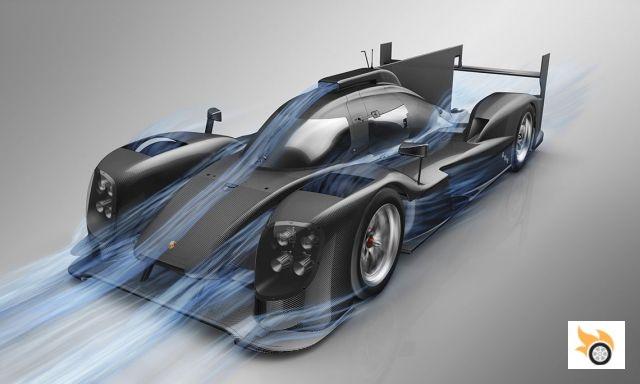
Aerodynamically, thanks to employing the "magic" suspension described above, the 919 is an extremely effective car at consistently getting the most out of its downforce. The constant improvement of the 2014 concept allowed in 2015 to design a new front diffuser that seems to let more air under the front axle and make better use of it, thanks to the control of the angle of attack (at pitch) of the car. Audi, to achieve active control of the car's pitch, employs an interconnected front and rear suspension system, a concept that in Formula 1 was used under the name FRIC, and would eventually be banned, but at Le Mans there are no such problems of bans. But Audi's system is more complex, and due to its interconnection (it's only front-rear, and not crossed between left-right wheels) it seems to be a bit more of a problem, with some unwanted bouncing. In that sense, Porsche's "magic suspension" system is simpler (it's purely mechanical), lighter and more reliable.
The other major part of the car's evolution was to understand the needs of the tyres and to be able to use the right compound at the right time. Clearly, with 30 kilograms less on the scales compared to 2014, the 919 Hybrid could play better at Le Mans, but it was vital to improve the use of the suspension system and the power delivery of the hybrid system to work the lap times in the stints, and not fry the tyres in the race.
1,000 horsepower to win at Le Mans
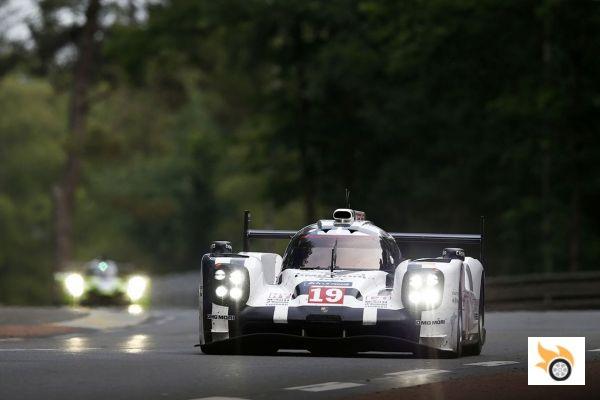
Before the race, inquiring about the Porsche 919 Hybrid, two figures appeared and made clear the capacity of the Stuttgart machine. It seemed that, set up for the best possible time, the 919 Hybrid could lap in a high 3:14 at La Sarthe. Not only well under the pole record at the circuit, but also much faster than the rest of its rivals.
But the problem was not in going faster than the others, but in knowing how to manage the race. Le Mans is not won in qualifying, and Porsche knows that well. The 919 Hybrid took pole position with no problems, all things considered, with a high downforce setting. But at Le Mans they tend to save a lot for the race, and they also play with a different configuration. In qualifying you have more downforce, to be fast in the Porsche sprint and do a good time, but you sacrifice top speed (up to 10 km/h). In the race you are looking for more top speed, to overtake the others more easily and spend less fuel, and you sacrifice cornering.
Porsche configured its car to be fast on the straights, but still, even with 1,000 horsepower and playing in the category of 8 MJ, the tip was 5 km / h lower than the less powerful Audi R18 e-tron. It didn't matter. Although in the melee it seemed that Audi could cough them, the reality is that the acceleration out of the chicanes was such for the Porsche that in the combined sector of the straight of Hunaudieres was practically a second to the R18 e-tron, which only ran more in the last part of the straight, when the Porsche was already struggling with the aerodynamics and without the support of the electric motor.
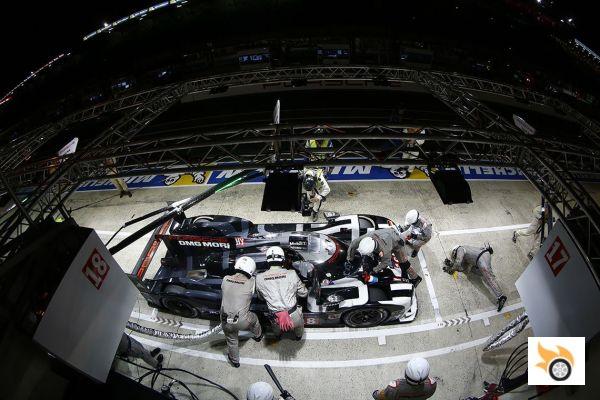
But the key was to know how to run "as little as possible" to win the race. The 919 Hybrid suffered in the first two rounds of the WEC precisely by failing in that, in mismanaging their stints, to spend a lot of tires and harm the full pace of each batch between refuels. At Le Mans the 919 took advantage of its thousand horsepower to accelerate faster than anyone else, but did not exhibit meteoric speed on a lap. Although in certain phases of the race it could do a comfortable 3:16, it was content to lap in 3:20, to change tires every three pit stops and maintain a consistent pace, which lap by lap, adding everything up, would end up being unattainable for Audi, even if it hadn't had the reliability problems it ended up having.
It was a big difference from last year, when the Porsche was "running as fast as it could run". This year we saw a team that had calculated everything down to the millimetre, with a car that was fastest on one lap, but also proved to be the fastest at a steady pace, matching it all with reliability.
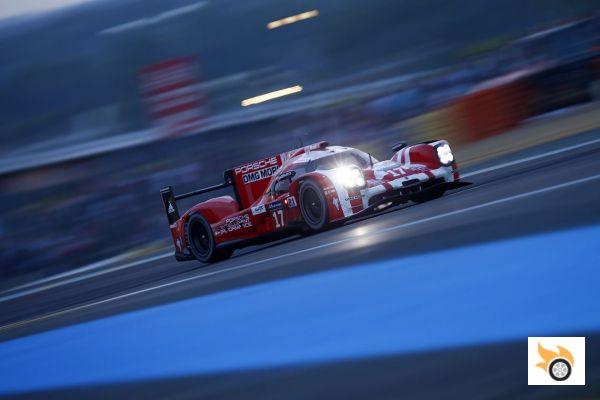
How much of the car's success was due to the invention of the magic suspension? Well, a significant part of it. But suspension doesn't really win races (at best it can make you drop out). It's the whole package that matters, and that's where Porsche has really shone: putting in a new turbo, a nearly new engine, the most powerful energy regeneration system on the grid, and suspension and aerodynamics like no one else. It is the sum of all these parts, when they have managed to make them work like clockwork, and have added it to a correct management of race pace and tire consumption that has led them to win.
Now it remains to be seen how much of what they have learned here will be transferred to Porsche's road cars. And knowing these Germans, it's sure to be more than we would expect from other manufacturers. After all, they've already put racing engines in road cars (hello Carrera GT).




